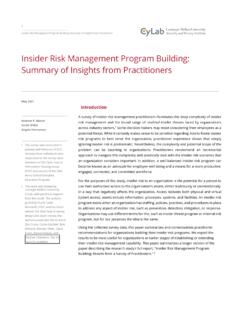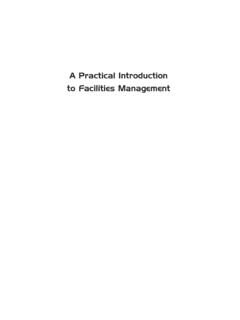Transcription of Risk Management in Public Sector: A Literature Review
1 ISSN 2414-8385 (Online) ISSN 2414-8377 (Print European Journal of Multidisciplinary Studies May-August 2017 Volume 2, Issue 5 323 Risk Management in Public sector : A Literature Review Remzi Ahmeti Raiffeisen Bank Kosovo Dr. Besarta Vladi European University of Tirana Abstract Public sector today faces a variety of complex and challenging events, and adequate measures are required in order to ensure that the perceived Public value is maintained at certain levels. There is a treasure of Literature available for the theory of risk and risk Management in private sector , mainly with focus in financial and banking sector . Nonetheless, there is a gap in the Literature regarding risk Management in Public sector .)
2 There is no well-established theoretical background of strategic risk Management in Public sector and most of the available Literature focus only on the risk estimation and fail to further contribute to how these estimations can be introduced to the decision-making process within Public authorities. For this reasons, this paper aims to present a Review of the most sound Literature on risk Management in Public sector and a special focus will be given to the identification of current Literature gaps and possible future research areas. Keywords: Risk, Risk Management Process, Public sector , ISO 31000:2009. introduction Risk Management is a critical task to be performed by organizations if they want to achieve their business goals and objectives (Lark, 2015).
3 Normally, regardless the sector , organizations should have a clear vision on what does risk mean to them and try to establish a tolerance range so they can better truck the risk and take necessary measures when needed. This is known as well as strategic benchmark (OECD, Advances in Risk Management of Government Debt, 2005) (pp. 13). Effective Management of risk is not about risk elimination, it is more about deciding for possible future event weather is better to take them (OECD, 2014, p. 13), accept them as they are, or refuse by mitigation or trying for a full elimination of the consequences. Worldwide, governments face the challenge to better manage their daily risks . At the same time, there is an increasing demand for risk Management , especially for governments, mainly following past financial and economic crises or increase in terrorist threats.
4 There is no difference for Public sector ; or better to say, the key difference in between risk Management in Public sector from the private one is that risk in the first case is much more complex and the scope of its impact is societal. Institutions in Public sector are generally large and highly bureaucratic, making difficult any incentive towards risk Management in this sector (Dobrea & Ene, 2006). The degree and variety of risks government bodies face in their daily activity is enormous and the key responsibility of these authorities is to assure the Public that no current or potential risk will threat the perceived Public value. Most of the time, Public institutions have to deal as well with many risks which practically are responsibility of private sector but they are just not well equipped or willing to do so (Braig, Gebre, & Sellgren, 2011).
5 According to (Bozeman & Kingsley, 1998) suggest that neither private sector nor Public one have riskier or less risky cultures, what makes the main difference is the way how they respond to the identified risks . Research objectives and methodology The main objective of this research paper is to provide a preview of existing Literature regarding risk Management in Public sector , to identify key issues raised by authors and to suggest future possible researches in this area. Attention is paid to the selection of research and reports included in this paper. Relatively recent researches are considered and their impact ISSN 2414-8385 (Online) ISSN 2414-8377 (Print European Journal of Multidisciplinary Studies May-August 2017 Volume 2, Issue 5 324 factor was important in the selection.)
6 Selected papers and researches are only in English language and they are presented in international journal and conferences. No empirical model is used and no data set was needed. Theory of Risk Risk as a concept and its terminology There are many definitions of risk as a concept and most of authors agree as well that risk is a hardly definable concept. In other words, most of authors try to offer definitions for a concept that is just different in different organizations and contexts. What is high for someone, can be perceived as low for someone else; what is a threat for a manager is an opportunity for another one. Simply said, risk is a perceptions and individual reaction towards the unknown. In general, incorporating industry specific characteristics with the organizations profile may generate a case specific and more accurate definition.
7 Among the earlies definition in the field of Management is the one provided by Keynes (1937) who makes a distinction between risk and uncertainty according to him, risk is a scenario where the probability is known and uncertainty is the event where the probability is not accurately known (Hopkins & Nightingale, 2006, p. 358). (Althaus, 2005) provides several definitions based on the context of the risk. His work on defining risk is shown in Table1. Source: (Althaus, 2005, p569) Referring to (Queensland, 2011) Report a general statement of risk we may accept as if there is an element of uncertainty surrounding an event, then risk exists. Since 2009 with the introduction of ISO standard for risk Management , risk Management became more standardized and managers around the world embraced this incentive for a common language of risk.
8 ISO definition of risk is simple and straightforward: effect of uncertainty on objectives (ISO, 2017). Risk Management Process Risk Management process is the step-by-step approach for identifying, assessing and responding to risks . In addition communication of the identified risk to the relevant stakeholders is a critical step in this process (Queensland, 2011, p. 7). The same as per risk definitions, through the Literature there are presented different risk Management processes. (Leung & Isaacs, 2008) present a simple three step model: risk identification, risk measurement and assessment, and decision-ISSN 2414-8385 (Online) ISSN 2414-8377 (Print European Journal of Multidisciplinary Studies May-August 2017 Volume 2, Issue 5 325 making.)
9 Nonetheless, since the introduction of ISO standard in 2009 offered a more comprehensive model, consisting in 7 steps and easy applicable in different industries and sectors, including Public sector . This model is shown in Figure 2. Figure 2: The ISO 31000:2009 risk Management process (Lark, 2015, p. 14) As can be seen from the diagram, risk Management key steps are: establishing the context, risk identification, risk analysis, risk evaluation, risk treatment, communication and consultation, and monitoring and Review . Even though shown separated, there is a continuity and overlap of the steps. This model is a good start for a risk Management process nonetheless organizations are encouraged to develop further this model based on their specific organizational requirements (Queensland, 2011, p.)
10 17). Towards a common standard in risk Management ISO is an independent, non-governmental membership organization and the main developer of voluntary international standards (Dali & Lajtha, 2012). ISO 31000:2009 is a short but very comprehensive set of principles and guidelines on risk Management . As an overview of the standard, it is a 23 pages document that presents 11 principles, a framework, and a process, which can be tailored, based on the specific organizational requirements (Lark, 2015). This standard was introduced in 2009 and since then has been widely used worldwide (Dali & Lajtha, 2012). ISO standard is designed for a wide range of users, applicable in different organizations and sectors.




